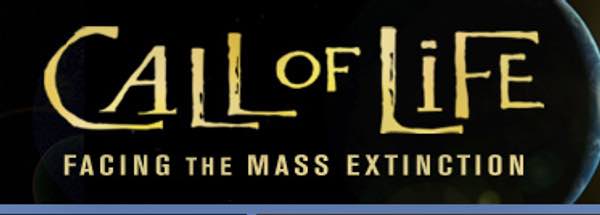
We recently discovered Call of Life, the 2010 documentary on species extinction, and thought it would be useful to see where we are today, Unfortunately, the situation is worse than we had imagined, and is continuing to worsen still.
Calling it a “biological annihilation,” the authors of a recent peer-reviewed study write, “humanity needs to address anthropogenic population extirpation and decimation immediately…. Our data indicate that beyond global species extinctions Earth is experiencing a huge episode of population declines and extirpations, which will have negative cascading consequences on ecosystem functioning and services vital to sustaining civilization…. Dwindling population sizes and range shrinkages amount to a massive anthropogenic erosion of biodiversity and of the ecosystem services essential to civilization. This ‘biological annihilation’ underlines the seriousness for humanity of Earth’s ongoing sixth mass extinction event.”
Well, what can we do about this? The first thing is to understand it better, to comprehend the range of causes and what can be done about them. The WWF’s Living Planet 2016 Report comes to some equally stark conclusions:
The 2016 report is an essential assessment of the state of the planet and it is a shock to read. It synthesizes the mountain of evidence showing the Earth system is under increasing threat: climate, biodiversity, ocean health, deforestation, the water cycle, the nitrogen cycle, the carbon cycle…. the planetary stability our species has enjoyed for 11,700 years, that has allowed civilization to flourish, can no longer be relied upon.
Yet there is hope that the very nature of the biodiversity crisis — that it is man-made — can be the key to overcoming it:
Given our current trajectory toward unacceptable conditions that are predicted for the Anthropocene era, there is a clear challenge for humanity to alter our course so that we operate within the environmental limits of our planet and maintain or restore resilience of ecosystems. Our central role as driving force into the Anthropocene also gives reason for hope. Not only do we recognize the changes that are taking place and the risks they are generating for nature and society, we also understand their causes.
At the most fundamental level, then, we must begin to to think about the Earth, and about ourselves, differently. Our culture, our collective consciousness, needs to start from the health of the planet in evaluating our economic activity. And then we must look, pragmatically, at what’s required to restore the functioning of Earth’s natural systems.
Earth’s species and habitats have their own intrinsic value, but they also form the foundation of human societies and economies. Efforts must particularly focus on protecting and restoring key ecological processes necessary for food, water and energy security, as well as climate change resilience and adaptation. To adequately protect natural capital, resources need to be used sustainably, and the global network of protected areas needs to be expanded. Adequate funding mechanisms are needed if protected area management is to be effective.
This in turn means “transitioning” our economy to one that is based on sustainable ecosystem management. This is where our focus as an organization truly is: on shifting the economic incentives in our current system to support the restorative values we need to avoid system collapse. We think of this in broad terms as “regenerative financing”: financing that supports natural systems regeneration, ecovillages, clean energy, organic farming, reforestation, and the restoration of the commons as profitable activities in the very deepest sense.

